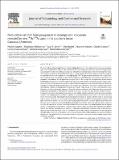Files in this item
Post-collisional shift from polygenetic to monogenetic volcanism revealed by new 40Ar/39Ar ages in the southern Lesser Caucasus (Armenia)
Item metadata
| dc.contributor.author | Sugden, Patrick | |
| dc.contributor.author | Meliksetian, Khachatur | |
| dc.contributor.author | Savov, Ivan | |
| dc.contributor.author | Barfod, Dan | |
| dc.contributor.author | Wilson, Marjorie | |
| dc.contributor.author | Connor, Charles | |
| dc.contributor.author | Navasardyan, Gevorg | |
| dc.contributor.author | Grigoryan, Edmond | |
| dc.contributor.author | Manucharyan, David | |
| dc.date.accessioned | 2021-09-16T08:30:09Z | |
| dc.date.available | 2021-09-16T08:30:09Z | |
| dc.date.issued | 2021-04 | |
| dc.identifier | 275858257 | |
| dc.identifier | e2641e7b-9915-4d24-8f58-e2dbae907013 | |
| dc.identifier | 85101072132 | |
| dc.identifier.citation | Sugden , P , Meliksetian , K , Savov , I , Barfod , D , Wilson , M , Connor , C , Navasardyan , G , Grigoryan , E & Manucharyan , D 2021 , ' Post-collisional shift from polygenetic to monogenetic volcanism revealed by new 40 Ar/ 39 Ar ages in the southern Lesser Caucasus (Armenia) ' , Journal of Volcanology and Geothermal Research , vol. 412 , 107192 . https://doi.org/10.1016/j.jvolgeores.2021.107192 | en |
| dc.identifier.issn | 0377-0273 | |
| dc.identifier.uri | https://hdl.handle.net/10023/23970 | |
| dc.description | Argon isotopic analyses were funded by NERC grant to I. Savov, IP-1690-1116. PJS was funded through a NERC studentship as part of the Leeds York Spheres Doctoral Training Partnership (DTP) (grant number NE/L002574/1). Part of the field work and research were supported by base funding of the Institute of Geological Sciences (IGS) and a thematic project by the Science Committee of the Armenian Ministry of Education and Science (project #18 T-1E368). | en |
| dc.description.abstract | The post-collisional Syunik and Vardenis volcanic highlands, located in the southern Lesser Caucasus mountains (part of the Arabia-Eurasia collision zone) are host to over 200 monogenetic volcanoes, as well as 2 large Quaternary polygenetic volcanoes in the Syunik highland. The latter are overlain by lavas from the monogenetic volcanoes, suggesting there was a transition in the style of volcanic activity from large-volume central vent eruptions to dispersed small-volume eruptions. 12 new high quality 40Ar/39Ar ages are presented here, with 11 ages calculated by step-heating experiments on groundmass separates, and the final age obtained from total fusions of a population of sanidines. All the ages were younger than 1.5 Ma, except for one ignimbrite deposit whose sanidines gave an age of 6 Ma. While the bulk of the exposed products of post-collisional volcanism relate to Pleistocene activity, it is clear there has been active volcanism in the region since at least the late Miocene. All ages for monogenetic volcanoes in the Syunik highland are younger than 1 Ma, but to the north in Vardenis there is geochronological evidence of monogenetic volcanism at 1.4 and 1.3 Ma. An age of 1.3 Ma is determined for a lava flow from one of the polygenetic volcanoes- Tskhouk, and when combined with other ages helps constrain the timing of the polygenetic to monogenetic transition to around 1 Ma. The new ages illustrate a degree of spatio-temporal coupling in the formation of new vents, which could be related to pull-apart basins focussing ascending magmas. This coupling means that future eruptions are particularly likely to occur close to the sites of the most recent Holocene activity. The polygenetic to monogenetic transition is argued to be the result of a decreasing magma supply based on: (i) volume estimates for Holocene eruptions and for all monogenetic volcanoes and their lava flows in Syunik; and (ii) the volcanic stratigraphy of the Lesser Caucasus region which shows late Pliocene- early Pleistocene continental flood basalts being succeeded by a few large andesite-dacite volcanoes and then the most recent deposits consisting of small-volume scoria cones. The Syunik highland has the highest density of monogenetic centres in the Lesser Caucasus, which is taken to indicate this region has the highest magma flux, and was therefore the last location to transition to monogenetic volcanism, which is why the transition is most clearly seen there. There is no evidence from Sr-Nd-B isotope measurements for the exhaustion of fusible slab components in the mantle source, showing that an inherited slab signature can survive for millions of years after the end of subduction. Although volcanism in the Lesser Caucasus is currently waning, a future pulse of activity is possible. | |
| dc.format.extent | 18 | |
| dc.format.extent | 6590170 | |
| dc.language.iso | eng | |
| dc.relation.ispartof | Journal of Volcanology and Geothermal Research | en |
| dc.subject | 40Ar/39Ar dating | en |
| dc.subject | Lesser Caucasus | en |
| dc.subject | Monogenetic volcanoes | en |
| dc.subject | Post-collisional volcanism | en |
| dc.subject | QE Geology | en |
| dc.subject | DAS | en |
| dc.subject | NIS | en |
| dc.subject.lcc | QE | en |
| dc.title | Post-collisional shift from polygenetic to monogenetic volcanism revealed by new 40Ar/39Ar ages in the southern Lesser Caucasus (Armenia) | en |
| dc.type | Journal article | en |
| dc.contributor.institution | University of St Andrews. School of Earth & Environmental Sciences | en |
| dc.identifier.doi | https://doi.org/10.1016/j.jvolgeores.2021.107192 | |
| dc.description.status | Peer reviewed | en |
| dc.identifier.url | https://www.sciencedirect.com/science/article/pii/S0377027321000214?via%3Dihub#s0065 | en |
This item appears in the following Collection(s)
Items in the St Andrews Research Repository are protected by copyright, with all rights reserved, unless otherwise indicated.

